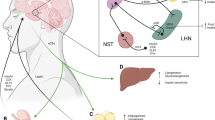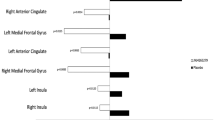Abstract
Amphetamine is a stimulant drug that enhances attention and feelings of alertness. Amphetamine's effects are known to be modulated by endogenous cannabinoids, which are degraded by the enzyme fatty acid amide hydrolase (FAAH). In this study we investigated inter-individual differences in mood response to amphetamine in relation to four polymorphisms in the FAAH gene, including the FAAH missense variant rs324420C → A (Pro129Thr), which was previously found to be associated with street drug use and addictive traits. One hundred and fifty-nine healthy Caucasian volunteers participated in a three-session, double-blind crossover study receiving either placebo or oral d-amphetamine (10 and 20 mg). Associations between individual genotypes and levels of self-reported Arousal (Profile of Mood States) after d-amphetamine ingestion were investigated using two-way ANOVAs/ANCOVAs. Association analyses for haplotypes were performed using the adaptive permutation approach implemented in PLINK. Genotypes at rs3766246 and rs2295633 were significantly associated with increased ratings of Arousal (p<0.05) and Fatigue (p<0.01) after the 10-mg dose. Fatigue levels were also found to be associated with the haplotypes CCC and TAT formed from rs3766246, rs324420, and rs2295633 (p<0.05). These data suggest that the endocannabinoid system influences variation in subjective response to amphetamine. This has important implications for understanding the role of endogenous cannabinoids in response to amphetamine, studies of poly-substance abuse, and understanding the genetic determinants of inter-individual differences in stimulant effects and risk of abuse.
Similar content being viewed by others
Log in or create a free account to read this content
Gain free access to this article, as well as selected content from this journal and more on nature.com
or
References
American Psychiatric Association (1994). Diagnostic and Statistical Manual of Mental Disorders, 4th edn. American Psychiatric Press Inc: Washington, DC.
Barch DM, Carter CS (2005). Amphetamine improves cognitive function in medicated individuals with schizophrenia and in healthy volunteers. Schizophr Res 77: 43–58.
Bishop C, Roehrs T, Rosenthal L, Roth T (1997). Alerting effects of methylphenidate under basal and sleep-deprived conditions. Exp Clin Psychopharmacol 5: 344–352.
Brauer LH, de Wit H (1996). Subjective responses to d-amphetamine alone and after pimozide pretreatment in normal healthy volunteers. Biol Psychiatry 39: 26–32.
Caldwell JA, Caldwell JL, Darlington KK (2003). Utility of dextroamphetamine for attenuating the impact of sleep deprivation in pilots. Aviat Space Environ Med 74: 1125–1134.
Cheng CH, Wooten GF (1982). Dopamine turnover estimated by simultaneous LCEC assay of dopamine and dopamine metabolites. J Pharmacol Methods 8: 123–133.
Chiang K, Gerber AL, Sipe JC, Cravatt BF (2004). Reduced cellular expression and activity of the P129T mutant of human fatty acid amide hydrolase: evidence for a link between defects in the endocannabinoid system and problem drug use. Hum Mol Genet 13: 1–7.
Crabbe JC, Jarvik LF, Liston EH, Jenden DJ (1983). Behavioral responses to amphetamine in identical twins. Acta Genet Med Gemellol (Roma) 32: 139–149.
Cravatt BF, Demarest K, Patricelli MP, Bracey MH, Giang DK, Martin BR et al (2001). Supersensitivity to anandamide and enhanced endogenous cannabinoid signaling in mice lacking fatty acid amide hydrolase. Proc Natl Acad Sci USA 98: 9371–9376.
De Vries TJ, Schoffelmeer AN (2005). Cannabinoid CB1 receptors control conditioned drug seeking. Trends Pharmacol Sci 26: 420–426 .
de Wit H, Uhlenhuth EH, Johanson CE (1986). Individual differences in the reinforcing and subjective effects of amphetamine and diazepam. Drug Alcohol Depend 196: 341–360.
Derogatis L (1983). SCL-90-R Manual II. Clinical Psychometric Research: Towson, Maryland.
Di Franza JR, Di Franza JA, Savageau K, Fletcher K, Ockene JK, Rigotti NA et al (2004). Recollections and repercussions of the first inhaled cigarette. Addict Behav 29: 261–272.
Di S, Malcher-Lopes R, Halmos KC, Tasker JG (2003). Nongenomic glucocorticoid inhibition via endocannabinoid release in the hypothalamus: a fast feedback mechanism. J Neurosci 23: 4850–4857.
Dlugos A, Freitag C, Hohoff C, McDonald J, Cook EH, Deckert J et al (2007). Norepinephrine transporter gene variation modulates acute response to D-amphetamine. Biol Psychiatry 61: 1296–1305.
Doehring A, Geisslinger G, Lötsch J (2007). Rapid screening for potentially relevant polymorphisms in the human fatty acid amide hydrolase gene using pyrosequencing. Prostaglandins Other Lipid Mediat 84: 128–137.
Fergusson DM, Horwood LJ, Lynskey MT, Madden PA (2003). Early reactions to cannabis predict later dependence. Arch Gen Psychiatry 60: 1033–1039.
Flanagan JM, Gerber AL, Cadet JL, Beutler E, Sipe JC (2006). The fatty acid amide hydrolase 385 A/A (P129T) variant: haplotype analysis of an ancient missense mutation and validation of risk for drug addiction. Hum Genet 120: 581–588.
Gabbay FH (2003). Variations in affect following amphetamine and placebo: markers of stimulant drug preference. Exp Clin Psychopharmacol 11: 91–101.
Gainetdinov RR, Wetsel WC, Jones SR, Levin ED, Jaber M, Caron MG (1999). Role of serotonin in the paradoxical calming effect of psychostimulants on hyperactivity. Science 283: 397–401.
Greenhill LL, Pliszka S, Dulcan MK, Bernet W, Arnold V, Beitchmann J (2002). Practice parameter for the use of stimulant medications in the treatment of children, adolescents, and adults. J Am Acad Child Adolesc Psychiatry 41: 26–49.
Haertzen CA, Kocher TR, Miyasato K (1983). Reinforcements from the first drug experience can predict later drug habits and/or addiction: results with coffee, cigarettes, alcohol, barbiturates, minor and major tranquilizers, stimulants, marijuana, hallucinogens, heroin, opiates and cocaine. Drug Alcohol Depend 11: 147–165.
Haughey HM, Marshall E, Schacht JP, Louis A, Hutchison KE (2008). Marijuana withdrawal and craving: influence of the cannabinoid receptor 1 (CNR1) and fatty acid amide hydrolase (FAAH) genes. Addiction 103: 1678–1686.
Hill MN, Patel S, Carrier EJ, Rademacher DJ, Ormerod BK, Hillard CJ et al. (2005). Downregulation of endocannabinoid signaling in the hippocampus following chronic unpredictable stress. Neuropsychopharmacology 30: 508–515.
Hodgkinson CA, Yuan Q, Xu K, Shen PH, Heinz E, Lobos EA et al (2008). Addictions biology: haplotype-based analysis for 130 candidate genes on a single array. Alcohol Alcohol 43: 505–515.
Hohoff C, McDonald JM, Baune BT, Cook EH, Deckert J, de Wit H (2005). Interindividual variation in anxiety response to amphetamine: possible role for adenosine A2A receptor gene variants. Am J Med Genet B Neuropsychiatr Genet 139B: 42–44.
Huitron-Resendiz S, Sanchez-Alavez M, Wills DN, Cravatt BF, Henriksen SJ (2004). Characterization of the sleep–wake patterns in mice lacking fatty acid amide hydrolase. Sleep 27: 857–865.
Johanson CE, Uhlenhuth CH (1980). Drug preference and mood in humans: diazepam. Psychopharmacology (Berl) 71: 269–273.
Kathuria S, Gaetani S, Fegley D, Valiño F, Duranti A, Tontini A et al (2002). Modulation of anxiety through blockade of anandamide hydrolysis. Nat Med 9: 76–81.
Kim H, Mittal DP, Ladarola MJ, Dionne RA (2006). Genetic predictors for acute experimental cold and heat pain sensitivity in humans. J Med Genet 43: e40.
Kuhar MJ, Joyce A, Dominguez G (2001). Genes in drug abuse. Drug Alcohol Depend 62: 157–162.
Lott DC, Kim S, Cook Jr EH, de Wit H (2005). Dopamine transporter gene associated with diminished subjective response to amphetamine. Neuropsychopharmacology 30: 602–609.
Lott DC, Kim SJ, Cook EH, de Wit H (2006). Serotonin transporter genotype and acute subjective response to amphetamine. Am J Addict 15: 327–335.
Madsen MV, Peacock L, Werge T, Andersen MB (2006). Effects of the cannabinoid CB1 receptor agonist CP55,940 and antagonist SR141716A on d-amphetamine-induced behaviours in Cebus monkeys. J Psychopharmacol 20: 622–628.
Maldonado R, Valverde O, Berrendero F (2006). Involvement of the endocannabinoid system in drug addiction. Trends Neurosci 29: 225–232 Review.
Martin WR, Sloan JW, Sapira JD, Jasinski DR (1971). Physiologic, subjective, and behavioral effects of amphetamine, methamphetamine, ephedrine, phenmetrazine, and methylphenidate in man. Clin Pharmacol Ther 12: 245–258.
Mattay VS, Goldberg TE, Fera F, Hariri AR, Tessitore A, Egan MF et al (2003). Catechol O-methyltransferase val158-met genotype and individual variation in brain response to amphetamine. Proc Natl Acad Sci USA 100: 6186–6191.
McKinney MK, Cravatt BF (2005). Structure and function of fatty acid amide hydrolase. Annu Rev Biochem 74: 411–432.
McNair D, Lorr M, Droppleman DL (1971). Profile of Mood States. Educational and Industrial Testing Service: San Diego.
Moreira FA, Kaiser N, Monory K, Lutz B (2008). Reduced anxiety-like behaviour induced by genetic and pharmacological inhibition of the endocannabinoid-degrading enzyme fatty acid amide hydrolase (FAAH) is mediated by CB1 receptors. Neuropharmacology 54: 141–150.
Morita Y, Ujike H, Tanaka Y, Uchida N, Nomura A, Ohtani K et al (2005). A nonsynonymous polymorphism in the human fatty acid amide hydrolase gene did not associate with either methamphetamine dependence or schizophrenia. Neurosci Lett 376: 182–187.
Murillo-Rodriguez E (2008). The role of the CB1 receptor in the regulation of sleep. Prog Neuropsychopharmacol Biol Psychiatry 32: 1420–1427.
Murillo-Rodríguez E, Vázquez E, Millán-Aldaco D, Palomero-Rivero M, Drucker-Colin R (2007). Effects of the fatty acid amide hydrolase inhibitor URB597 on the sleep–wake cycle, c-Fos expression and dopamine levels of the rat. Eur J Pharmacol 562: 82–91.
Nurnberger Jr JI, Gershon ES, Simmons S, Ebert M, Kesller LR, Dibble ED et al (1982). Behavioral, biochemical and neuroendocrine responses to amphetamine in normal twins and ‘well-state’ bipolar patients. Psychoneuroendocrinology 7: 163–176.
Palmer AA, Verbitsky M, Suresh R, Kamens HM, Reed CL, Li N et al (2005). Gene expression differences in mice divergently selected for methamphetamine sensitivity. Mamm Genome 16: 291–305.
Patel S, Roelke CT, Rademacher DJ, Cullinan WE, Hillard CJ (2004). Endocannabinoid signaling negatively modulates stress-induced activation of the hypothalamic-pituitary–adrenal axis. Endocrinology 145: 5431–5438.
Pritchard JK, Stephens M, Donnelly P (2000). Inference of population structure using multilocus genotype data. Genetics 155: 945–959.
Rohde LA, Roman T, Szobot C, Cunha RD, Hutz MH, Biederman J (2003). Dopamine transporter gene, response to methylphenidate and cerebral blood flow in attention-deficit/hyperactivity disorder: a pilot study. Synapse 48: 87–89.
Rubino T, Realini N, Castiglioni C, Guidali C, Viganó D, Marras E et al (2008). Role in anxiety behavior of the endocannabinoid system in the prefrontal cortex. Cereb Cortex 18: 1292–1301.
Selzer ML (1971). The Michigan Alcoholism Screening Test: the quest for a new diagnostic instrument. Am J Psychiatry 127: 1653–1658.
Shastry BS (2006). Pharmacogenetics and the concept of individualized medicine. Pharmacogenomics J 6: 16–21.
Sipe JC (2004). The brain endogenous cannabinoid system: a role in reward/craving of addiction? Med Hypotheses Res 1: 1–10.
Sipe JC, Chiang K, Gerber AL, Beutler E, Cravatt BF (2002). A missense mutation in human fatty acid amide hydrolase associated with problem drug use. Proc Natl Acad Sci USA 99: 8394–8399.
Sipe JC, Waalen J, Gerber A, Beutler E (2005). Overweight and obesity associated with a missense polymorphism in fatty acid amide hydrolase (FAAH). Int J Obes (Lond) 29: 755–759.
Spencer TJ, Abikoff HB, Connor DF, Biedermann J, Pliszka SR, Boellner S et al (2006). Efficacy and safety of mixed amphetamine salts extended release (adderall XR) in the management of oppositional defiant disorder with or without comorbid attention-deficit/hyperactivity disorder in school-aged children and adolescents: a 4-week, multicenter, randomized, double-blind, parallel-group, placebo-controlled, forced-dose-escalation study. Clin Ther 28: 402–418.
Stranger BE, Forrest MS, Dunning M, Ingle CE, Beazley C, Thorne N et al (2007). Relative impact of nucleotide and copy number variation on gene expression phenotypes. Science 315: 848–853.
Sulzer D, Sonders MS, Poulsen NW, Galli A (2005). Mechanisms of neurotransmitter release by amphetamines: a review. Prog Neurobiol 75: 406–433.
Swerdlow NR, Koob GF, Cador M, Lorang M, Hauger RL (1993). Pituitary–adrenal axis responses to acute amphetamine in the rat. Pharmacol Biochem Behav 45: 629–637.
Taylor D, Ho BT (1978). Comparison of inhibition of monoamine uptake by cocaine, methylphenidate and amphetamine. Res Commun Chem Pathol Pharmacol 21: 67–75.
Thiemann G, Di Marzo V, Molleman A, Hasenöhrl RU (2008). The CB(1) cannabinoid receptor antagonist AM251 attenuates amphetamine-induced behavioural sensitization while causing monoamine changes in nucleus accumbens and hippocampus. Pharmacol Biochem Behav 89: 384–391.
Thierry-Mieg D, Thierry-Mieg J (2006). AceView: a comprehensive cDNA-supported gene and transcripts annotation. Genome Biol 7 (Suppl 1): 1–14.
Tyndale RF, Payne JI, Gerber AL, Sipe JC (2007). The fatty acid amide hydrolase C385A (P129T) missense variant in cannabis users: studies of drug use and dependence in Caucasians. Am J Med Genet B Neuropsychiatr Genet 144B: 660–666.
Veenstra-VanderWeele J, Qaadir A, Palmer AA, Cook Jr EH, de Wit H (2006). Association between the casein kinase 1 epsilon gene region and subjective response to D-amphetamine. Neuropsychopharmacology 31: 1056–1063.
Veyrieras JB, Kudaravalli S, Kim SY, Dermitzakis ET, Gilad Y, Stephens M et al (2008). High-resolution mapping of expression-QTLs yields insight into human gene regulation. PLoS Genet 4: e1000214.
White TL, Justice AJ, de Wit H (2002). Differential subjective effects of D-amphetamine by gender, hormone levels and menstrual cycle phase. Pharmacol Biochem Behav 73: 729–741.
Wilens TE, Biederman J, Spencer TJ (2002). Attention deficit/hyperactivity disorder across the lifespan. Annu Rev Med 53: 113–131.
Williamson S, Gossop M, Powis B, Griffiths P, Fountain J, Sttrang J (1997). Adverse effects of stimulant drugs in a community sample of drug users. Drug Alcohol Depend 44: 87–94.
Acknowledgements
We thank Drs Andrew Skol, Jonathan Prichard, Barbara Engelhardt, and Sridhar Kudaravalli for invaluable intellectual and technical support. We also thank Ms Margo Meverden and Ms Patricia Kriegel for skillful technical assistance. This work was supported by DA021336, DA02812 and MO RR00055.
Author information
Authors and Affiliations
Corresponding author
Additional information
DISCLOSURE
The authors declare no conflict of interest.
Supplementary Information accompanies the paper on the Neuropsychopharmacology website (http://www.nature.com/npp)
Rights and permissions
About this article
Cite this article
Dlugos, A., Hamidovic, A., Hodgkinson, C. et al. More Aroused, Less Fatigued: Fatty Acid Amide Hydrolase Gene Polymorphisms Influence Acute Response to Amphetamine. Neuropsychopharmacol 35, 613–622 (2010). https://doi.org/10.1038/npp.2009.166
Received:
Revised:
Accepted:
Published:
Issue date:
DOI: https://doi.org/10.1038/npp.2009.166
Keywords
This article is cited by
-
Endocannabinergic modulation of central serotonergic activity in healthy human volunteers
Annals of General Psychiatry (2023)
-
Novel associations between FAAH genetic variants and postoperative central opioid-related adverse effects
The Pharmacogenomics Journal (2015)
-
Risky alcohol consumption in young people is associated with the fatty acid amide hydrolase gene polymorphism C385A and affective rating of drug pictures
Molecular Genetics and Genomics (2014)
-
Fatty-acid amide hydrolase polymorphisms and post-traumatic stress disorder after penetrating brain injury
Translational Psychiatry (2012)
-
A polymorphism in the gene of the endocannabinoid-degrading enzyme FAAH (FAAH C385A) is associated with emotional–motivational reactivity
Psychopharmacology (2012)



